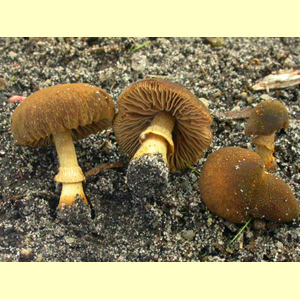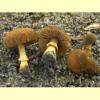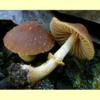


_sml.jpg)
_AG_35_sml.jpg)
The New Zealand species Descolea gunnii has been reported from Tasmania (as Gymnoglossum), but the particular collection more likely belongs to one of the truffle-like genera.
Setchelliogaster tenuipes is very similar to Descolea but no spore print is produced. Fruit-bodies are truffle-like and partially buried and the lamellae vary from normally-formed to labyrinthine.
Bougher, N.L. & Syme, K. (1998), Fungi of Southern Australia. University of Western Australia Press, Nedlands. [Description, Illustration and Microcharacters of D. maculata and Description and B&W Illustration of D. phlebophora]
Bougher, N.L. & Malajczuk, N. (1985), A new species of Descolea (Agaricales) from Western Australia, and aspects of its ectomycorrhizal status, Austral. J. Bot. 33: 619–627. [B&W Illustration and Microcharacters of D. maculata]
Brundrett, M., Bougher, N., Dell, B., Grove, T. & Malajczuk, N. (1996), Working with Mycorrhizas in Forestry and Agriculture. ACIAR Monograph 32. Australian Centre for International Agricultural Research, Canberra. [Illustration of D. phlebophora and Descolea sp.]
Fuhrer, B. (2005), A Field Guide to Australian Fungi. Bloomings Books, Hawthorn. [Description and Illustration of D. recedens and see also Setchelliogaster tenuipes]
Fuhrer, B. & Robinson, R. (1992), Rainforest Fungi of Tasmania and South-east Australia. CSIRO Press, East Melbourne. [Illustration of Descolea sp.]
Grgurinovic, C.A. (1997a), Larger Fungi of South Australia. The Botanic Gardens of Adelaide and State Herbarium and The Flora and Fauna of South Australia Handbooks Committee, Adelaide. [Description, Illustration and Microcharacters of D. recedens]
Grgurinovic, C.A. & Mallett, K. (eds) (1996), Fungi of Australia, Volume 1A. Australian Biological Resources Study, Canberra. [Illustration of D. recedens]
Horak, E. (1971), Studies on the genus Descolea Sing., Persoonia 6: 231–248. [Description, B&W Illustration and Microcharacters of D. phlebophora and D. recedens, and Key to the species of Descolea]
McCann, I.R. (2003), Australian Fungi Illustrated. Macdown Productions, Vermont. [Illustration of D. recedens]
Young, A.M. (2005b), A Field Guide to the Fungi of Australia. University of New South Wales Press, Sydney. [Description and B&W Illustration of D. recedens]
